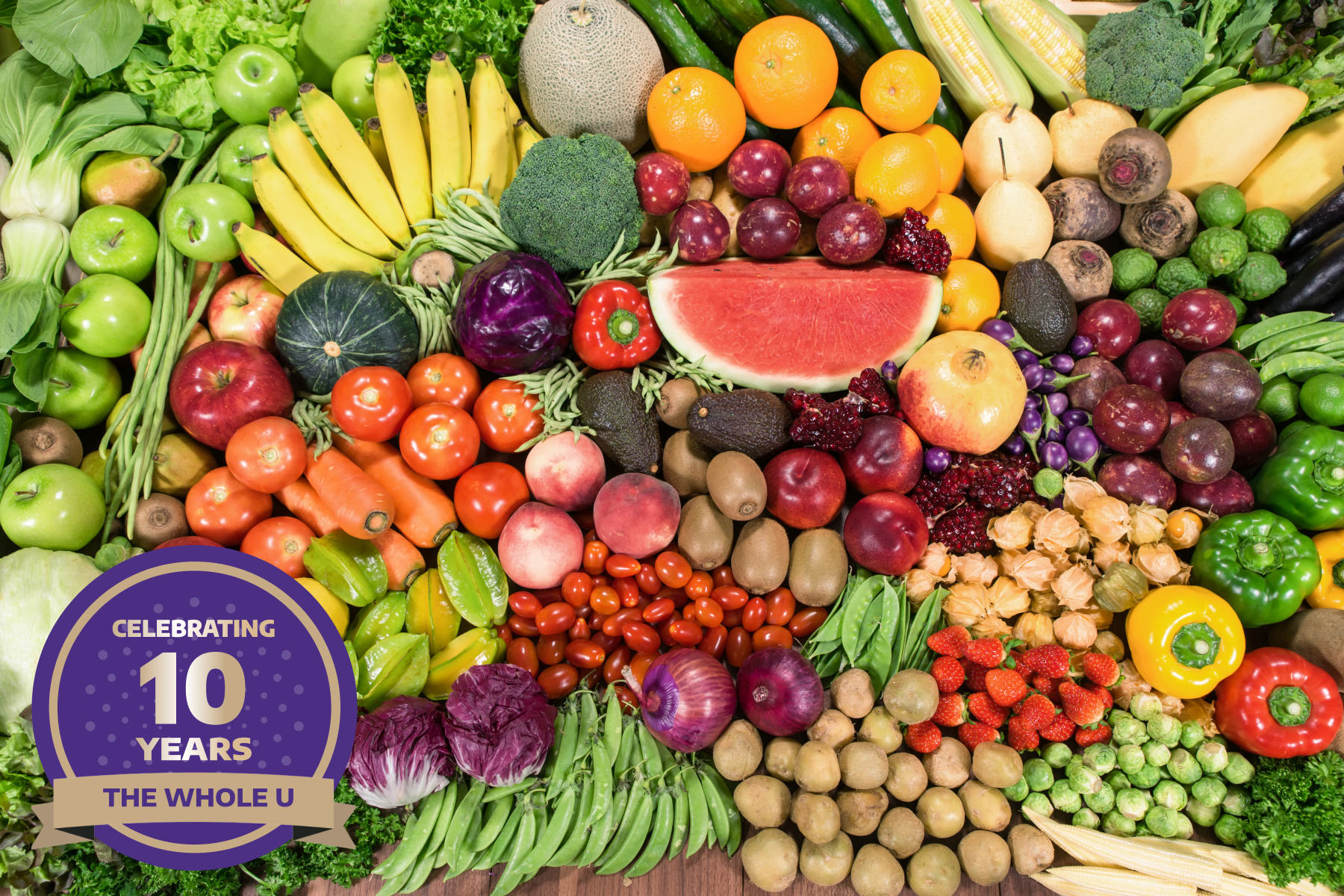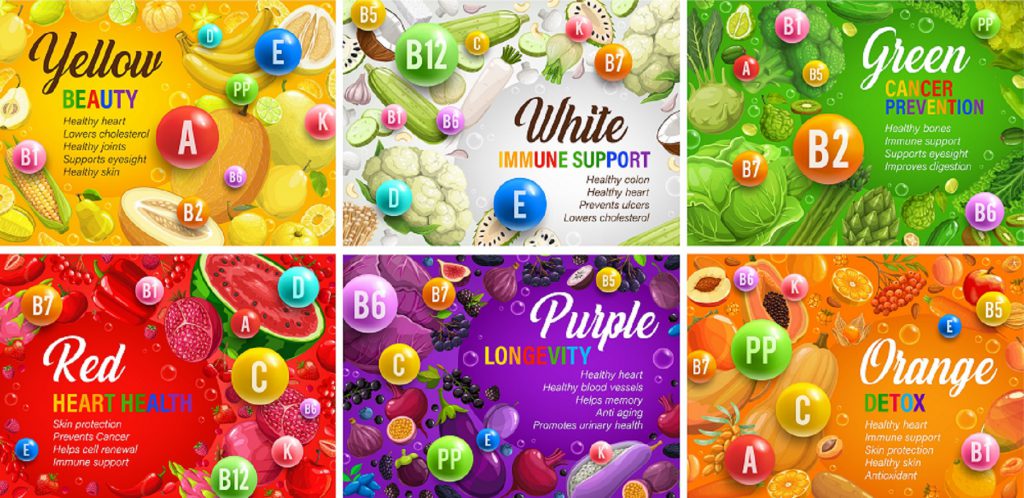
The health benefits of fruits and vegetables: taste the rainbow
The author Michael Pollan has boiled down the contents of several bestselling books and a lifetime of inquiry on healthy dining into a prescriptive motto with the economy of a haiku: “eat food, not too much, mostly plants.”
Mostly plants. It sounds like a virtuous sentiment. But why? What is it that fruits and vegetables provide that you can’t get from animal proteins, processed foods and supplements?
We asked UW Medicine dietitian Anna Fogel to help us understand why eating produce is so important to our health and well-being.
“From a dietitian’s perspective, we think about food as either being calorie dense or nutrient dense,” she says. “We categorize highly processed foods as calorie dense. Fruits and vegetables, lean protein and whole grains are nutrient dense. They have multiple components that are beneficial for our health. The most important are fiber and micronutrients (vitamins and minerals).”
Variety for life
The best source of fiber and micronutrients happens to be the most naturally occurring: fruits and vegetables, which deliver so many health benefits to all aspects of our bodies and operating systems. “Eating a variety of fruits and vegetables is a great way to maintain gut health and energy in the short term and to protect us against nutrition-related chronic illness as we get older,” Fogel says.
As anyone who has visited a grocery store produce section or farmer’s market in high season will know, fruits and vegetables come in an enormous variety of sizes, flavors, textures and colors. So, how do you know what your body needs?
Fortunately, all fruits and vegetables provide dietary fiber, which is essential to maintaining digestive health and safe levels of cholesterol, blood sugar and body weight. Beyond fiber, each type of produce, from apples to zucchini, supplies its own array of vitamins, minerals and antioxidants — substances that strengthen our cells and promote health and longevity.
Conveniently, the benefits of fruits and vegetables align with their colors.
“That’s why color is so important,” Fogel explains. “Different colors affect different parts of the body and aspects of our health.”
And so, she says, the best way to maximize the benefits of these incredible, edible plants is to turn your plate into a palette of colors. The brighter the better.
Eat a rainbow
Here is the general categorization of health benefits found in the richly pigmented rainbow of fruits and vegetables.
Red – High in antioxidants and carotenoids such as lycopene and rich in vitamin C, vitamin A and potassium, that provide anti-inflammatory properties, boost immune system and may protect against certain cancers, lower risk of heart and lung disease and reduce sun-related skin damage.
Examples: strawberries, pomegranates, cranberries, tomatoes, cherries, cherries, apples, beets, watermelon, red grapes, red peppers, red onions.
Yellow/Orange – Loaded with vitamin C, vitamin A and potassium that boost the immune system and enhance vision. Also a good source of cryptothanxin, which supports a complex microbiome, digestive health and reduces the risk of heart disease and cancer.
Examples: carrots, sweet potatoes, yellow peppers, oranges, bananas, pineapple, tangerines, mango, pumpkin, apricots, winter squash, peaches, cantaloupe, corn.
Green – High in a variety of nutrients, such as vitamin K, folate, magnesium and potassium, for maintaining cardiovascular health and vision, bones and teeth. Green veggies are rich in cancer-blocking chemicals like sulforaphane, isothiocyanates and indoles. Dark green, leafy vegetables have the highest concentrations of antioxidants and fiber. Cruciferous veggies are particularly helpful in lowering the risk of cancer and heart disease.
Examples: spinach, avocados, asparagus, artichokes, broccoli, kale, cabbage, lettuce, alfalfa sprouts, Brussels sprouts, kiwi fruit, collard greens, green tea, green herbs.
 Purple (and Blue) – Have powerful antioxidants called anthocyanins believed to delay cellular aging and support heart health. Also rich in polyphenols that support learning, memory and mood and lower the risk of heart disease, neurological disorders, type 2 diabetes and certain cancers.
Purple (and Blue) – Have powerful antioxidants called anthocyanins believed to delay cellular aging and support heart health. Also rich in polyphenols that support learning, memory and mood and lower the risk of heart disease, neurological disorders, type 2 diabetes and certain cancers.
Examples: blueberries, blackberries, elderberries, grapes, raisins, eggplants, plums, figs, prunes, lavender, purple cabbage.
White (and Brown) – Rich in potassium and magnesium. Support the immune system and heart health, and prevent against colon cancer and other cancers. The onion family contains allicin, which has anti-tumor properties. Other foods in this group contain antioxidant flavonoids like quercetin and kaempferol that control cholesterol levels.
Examples: onions, cauliflower, garlic, leeks, parsnips, potatoes, daikon, mushrooms, jicama, bananas, pears.
Fresh-picked vs. flash frozen
Fogel says that raw produce — with all its color, fiber and micronutrients intact — provides the greatest level of nutritional benefits. But you don’t always need to find fresh-picked fruits and vegetables, especially when they are out of season.
“We’re in the height of fresh produce season right now,” she says. “But it’s important to remember that canned and frozen fruits and vegetables have their place — especially during the winter.”
She recommends frozen produce, which is picked and processed at peak ripeness, so it delivers all the benefits of fresh produce.
Raw vs. cooked
Many fruits and vegetables can be eaten raw or cooked in a variety of ways. Which is better? Whichever works for you. Eating a crisp apple or a handful of snap peas out of hand can be a nutritious treat. But raw produce can make some people feel bloated or experience abdominal pain. “If you have a harder time digesting fresh fruits or vegetables, cooking is a great way to break down the fibrous structure,” Fogel says. “Plus, then you can add flavor into it, too.”
She adds that you shouldn’t worry about cooking out nutrients or fiber.
“The best way to prepare fruits and vegetables is the way that you enjoy them the most,” she says, “because that means you’re probably going to actually eat them.”
Salads, stir-fries and soups, oh my!
Speaking of which… there are innumerable ways to assemble or cook fruits and vegetables — or just eat them out of hand — to span this healthy rainbow in your diet. The key is to mix and match.
So, eating a green salad is good. But even better is eating a green salad with some orange carrots, red tomatoes, yellow peppers, white pears and blueberries. That is a nutritional powerhouse on your plate.
“If I’m eating the same-colored things all the time, whether they be fruits or vegetables, I’m probably not getting the most benefits I can out of my diet because I’m restricting myself,” Fogel says.
 Beyond salads, she recommends stir-fries, smoothies and soups as great ways to pack in a rainbow of colors, flavors and health benefits.
Beyond salads, she recommends stir-fries, smoothies and soups as great ways to pack in a rainbow of colors, flavors and health benefits.
“It’s summer so nobody is thinking about hot broths right now, but we’ll be there soon,” she says. “Soups are a fantastic way to add in different colors and amounts of fiber. And veggies cook quickly.”
Finicky eaters?
Have a finicky kiddo — or grownup — in your house? Or maybe even the resident picky eater is you?
Fogel says that repetition is the key to introducing new fruits and vegetables into your repertoire. It can take more than 10 tries to come to appreciate a new taste. And, yes, most people’s palates do change as they mature. Tastes can be acquired.
“We tell people to try to remain open to a food even if they have tried it before and didn’t like it,” she says.
For those with a list of don’t-likes, Fogel warns against hiding fruits and vegetables in foods they do like. “It’s essentially telling them, ‘I know you don’t like this but I’m going to force you to eat it without your knowledge,’” she says. “You’re veggie gaslighting them.”
Make it welcoming
Instead, Fogel recommends making fruits and vegetables as convenient as processed snack foods or take-out. Think pre-cut apple slices and baby carrots for lunch boxes, frozen fruit for smoothies and pre-cut mixed frozen veggies for quick weeknight stir fries or soups.
 “What we tell our patients is to set yourself up for success,” Fogel says.
“What we tell our patients is to set yourself up for success,” Fogel says.
Another bit of advice, especially for people living with picky eaters, is to model an appreciation of fruits and veggies and an openness to unfamiliar tastes and textures. It’s important for kids to see people around them enjoying a variety of healthy foods and trying new things. If you don’t like Brussels sprouts or bananas, don’t transfer this to your kids.
“Try to create a welcoming environment for all foods,” Fogel adds. “Our environment can make a huge difference in how we experience food. If everyone around us likes something we don’t think we like, we’ll probably be more open to trying it.”
Find your own bliss point
In the modern culinary world, processed convenience foods are omnipresent on store shelves and engineered to hit the “bliss point,” at which the melding of salt, sugar and fat proves difficult to resist. But they are empty calories at best.
Fruits and vegetables, on the other hand, come naturally packed with virtuous nutrients and enormous health benefits. And they can provide their own degree of bliss, once we can appreciate their natural sweetness and rich flavors.
A great way to get there is by eating your way across this agricultural rainbow every day. And the reward for doing so is greater health and wellness, now and in the future.
To Pollan’s proposition, Fogel might recommend an addendum: eat food, not too much, mostly plants, many colors.
The Whole U can help
Join Anna Fogel to learn more at The Whole U’s upcoming nutrition webinar on September 3.
Get more ideas and inspiration on healthy eating from The Whole U:
- UW Dietitian Cookbook
- 2020 Husky Cookbook
- Meal Planning Guide
- Kitchen Cooking Guide
- Guide to Reading Food Labels
- Guide to Navigating the Grocery Store
- Seasonal Produce Guide
- Power Bowl Recipes
- Mix and Match Salad Recipes
- Salad Dressing Recipes
- Meals in a Jar Recipes
- Breakfast Toast Recipes
- Quick and Easy Soup Recipes
- What a nutritious snack looks like
- Grilling fruits and vegetables
Find more at The Whole U!

One Thought on “The health benefits of fruits and vegetables: taste the rainbow”
On August 14, 2024 at 7:12 AM, Kelly E. Moore said:
I am always struggling with buying fresh vegetables because they can go bad so quickly if not used. This article provides great information for how to buy fruits and vegetables and great options for using them to get the best nutritional benefits. Thank you so much for publishing this article!
Comments are closed.